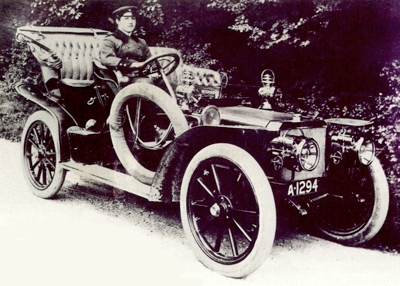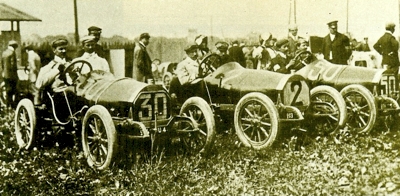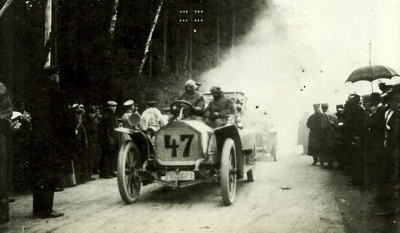'THE APPEARANCE OF A NEW STAR in the motoring world is always an interesting event, even though it may be difficult at first to calculate its exact magnitude,' wrote F. P. Armstrong of Country Life in October 1903. 'Little more than a month ago the Martini car was unknown to the majority even of motorists; today, owing to the courage and enterprise of Captain Deasy, it has taken a place among the cars whose names are familiar to the general public.'
Adolf von Martini
At that time, total production of the Martini car, built in Frauenfeld, Switzerland, by the famous armament manufacturer, amounted to little more than a hundred cars; Adolf von Martini, son of the inventor of the Martini-Henry rifle, had built his first experimental rear-engined car in 1897, following this with V4 cars of 10 hp and 16 hp in 1902.
Then came production under licence of the French Rochet-Schneider; and it was one of these cars that Captain H. H. P. Deasy, the British agent, had used in a daring publicity stunt. 'Last week, Captain Deasy secured for it a unique and world-wide advertisement by driving it up the cog-wheel railway that runs from Caux to Rochers de Naye, a feat that has been described in nearly every newspaper in the world ... the total distance covered in several journeys was nearly eighteen kilometres, a large proportion of which were on a gradient of 22.6 per cent, or about 1 in 4½'
The motor car in Switzerland was in a curiously difficult situation, as many of the cantons, or administrative districts, exhibited an almost medieval fear of the self-propelled vehicle, most notoriously the Canton of Grisons, which barred motor traffic altogether until 1924.
Captain H. H. P. Deasy
So, while Deasy's stunt had proved that the Martini was the right one for the mountainous roads of its home country, the marque had to depend on exports for its success. And, indeed, success came quickly. Demand, especially from England and France was sufficient to warrant the building of a new factory at St Blaise-Neuchatel, and in July 1904 Captain Deasy was off on the publicity trail once again.
This time he took a 16 hp Martini on a 2000 mile trip across the Alps, -accompanied part of the way by the journalist Georges Prade, who wrote: 'The automobile demonstrated its complete conquest of the Alps with an ease and elegance which both surprised and charmed' ... its running was marvellous in its regularity, smooth, and without ahitch.' Like its French prototype, the 16hp Martini had a bi-block engine with mechanically-operated inlet valves mounted in an armoured-wood chassis.
 1904 Martini Tourer.
1904 Martini Tourer.
 The Victorious Martini team just prior to the GP Des Voiturettes in 1908. The overhead cam 1086c cars finished in 7th, 8th and 10th positions, to take the Team prize.
The Victorious Martini team just prior to the GP Des Voiturettes in 1908. The overhead cam 1086c cars finished in 7th, 8th and 10th positions, to take the Team prize.
 Martini Numer 47 in the 1907 Herkomer Trophy.
Martini Numer 47 in the 1907 Herkomer Trophy. |
'The name Martini,' claimed Captain Deasy, 'conveys, as a matter of course, freedom from roadside troubles.' Although the control system (petrol cut-off giving natural brake, decelerator pedal giving foot control at will) offered more than a fair chance of catastrophe.
By 1906 Deasy was in sole command of the entire Martini output, a situation which lasted until 1908, even though he had just gone into manufacture under his own name of a car designed by F. W. Lewis, formerly with Rover.
Battle of the Cylinders - Martini vs. Rolls-Royce
And in the summer of 1906 came yet another publicity stunt, this time in the form of a challenge to Rolls-Royce on the basis that four Martini cylinders were' every bit as good as six Rolls ones, only to lose this 'Battle of the Cylinders' - a 4000-mile reliability trial - since the marks to be obtained for reliability were very large in proportion to what may be termed the amenities of travel. The challenger was a 40 hp Martini, the challenged a 30 hp Rolls-Royce; a 20 hp Martini was also available that season.
The next year saw a 28 hp Martini with chain drive, while 12 months later the range included 12 hp, 16 hp and 20 hp fours, all with shaft drive. Martini enjoyed a modest competition success in the 1908 Coupe des Voiturettes, in which a team of 1086 cc ohc models finished 7th, 8th and 10th to win the Team Prize; it was a far more prestigious showing than their entry in the 1907 Kaiserpreis, in which the marque took 13th and 15th places.
It was a development of this racing voiturette which was marketed in 1909 as the 10/12, with a single overhead camshaft operating inclined valves; its stablemates featured inlet-over-exhaust valves, with the inlets operated by pushrods and rockers.
All Martini engines were now cast monobloc, and the following season saw a reversion to sidevalves all round. There was, however, a further venture into unconventionality in 1913, when the 25/35 sleeve-valve model was listed, while a one-off single OHC 16-valve four-cylinder racer of the same year represented a last excursion into high performance, a commodity distinctly lacking in the marque's post-war offerings.
W. Steiger
The changed economic situation of 1920s Europe meant that the export markets essential to the survival of Martini were now closed against the marque; but nevertheless it took a while for the marque to finally wind up. The German manufacturer W. Steiger took over in 1924, and the following year Martini at last admitted defeat in the Battle of the Cylinders by introducing a range of six-cylinder cars, replaced in 1929 by a licence-built version of the Wanderer six from Chemnitz, Germany.
This lasted only a couple of years, as it didn't even sell on the undersized home market, and was replaced by the Type NF Martini, a 4.4 liter six with all-round hydraulic brakes, which was built, apparently, until 1934, though it had become the shadow of a shade long before the marque crept into an obscure corner of history and died.
